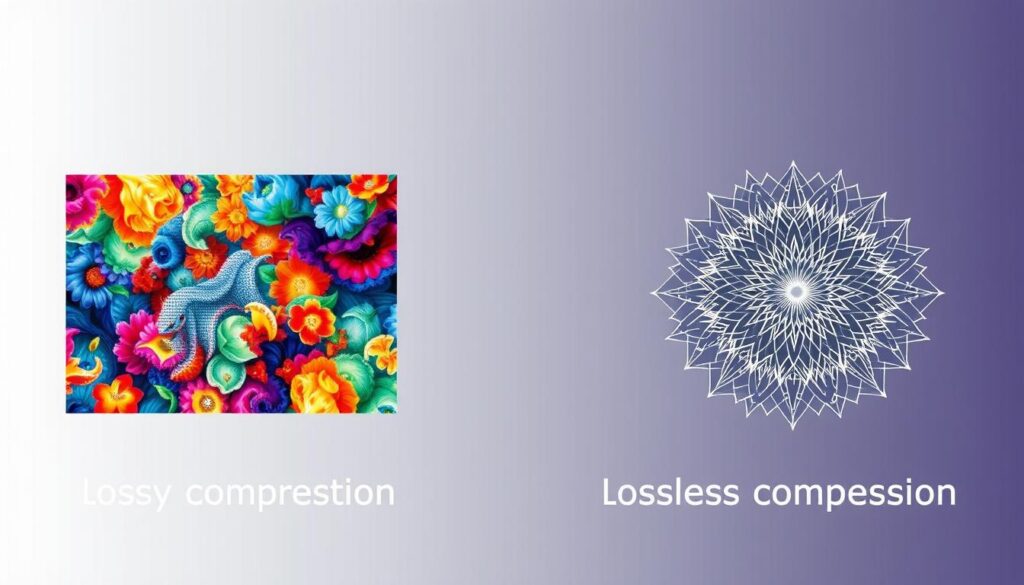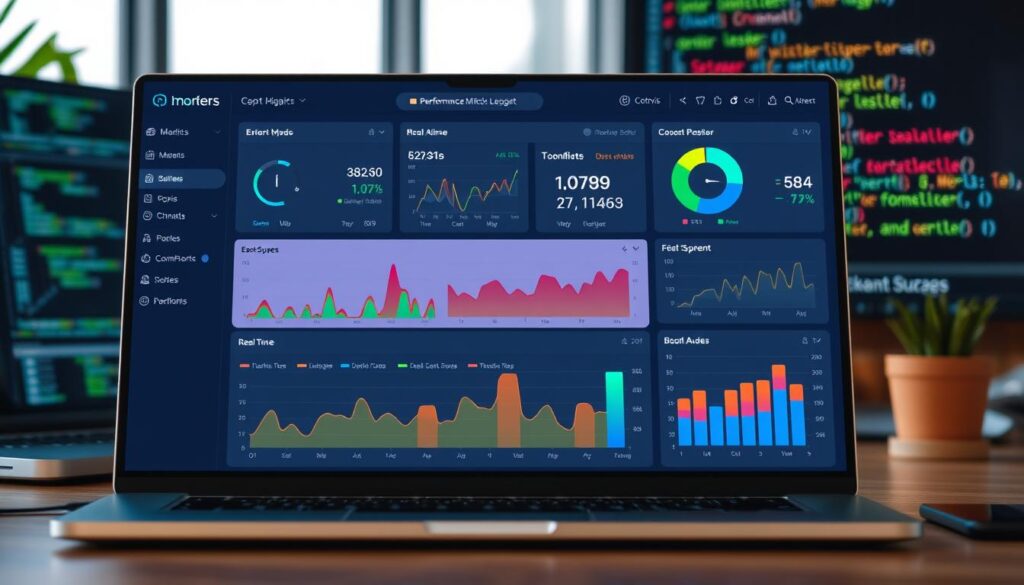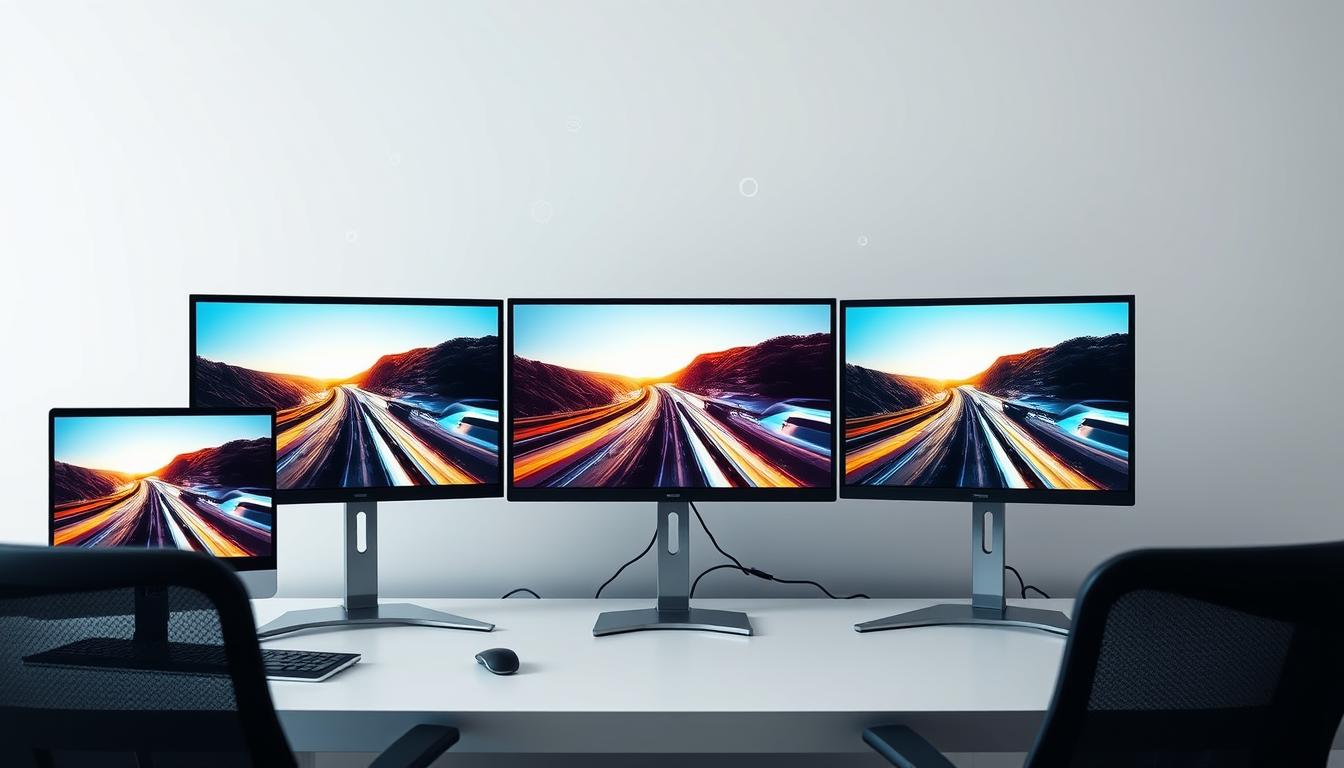In today’s fast-paced digital landscape, having a website that loads lightning-fast is crucial. But have you ever wondered how much of an impact your images can have on your website’s performance? The answer might surprise you. Optimized images can be the difference between a seamless user experience and a frustratingly slow one.
So, what’s the secret to unlocking your website’s full potential? In this comprehensive guide, we’ll delve into the world of image optimization. We’ll uncover the strategies that can transform your site’s performance. Get ready to discover the power of optimized images and how they can catapult your online presence to new heights.
Key Takeaways
- Optimized images can significantly improve website performance and user experience.
- Understanding the importance of file size, resolution, and format is crucial for effective image optimization.
- Exploring the latest image compression techniques and technologies can help you achieve the perfect balance between quality and file size.
- Implementing responsive image strategies ensures your visuals look great on any device.
- Leveraging browser caching and SEO-friendly image optimization practices can boost your website’s search engine rankings.
Understanding Image Optimization
In the digital era, images have become crucial for any successful website. However, unoptimized images can severely affect website speed and user experience. Image optimization is the art of preparing and delivering images in a manner that minimizes their file size without sacrificing quality.
What is Image Optimization?
Image optimization encompasses techniques such as image compression, format selection, and resolution management. These methods ensure images load swiftly and efficiently on a website. By optimizing images, website owners can enhance their site’s website speed and improve the overall user experience for their visitors.
Why is It Important for Websites?
- Faster page load times: Optimized images load more quickly, leading to improved website speed and a better user experience.
- Reduced bandwidth usage: Smaller file sizes mean less data transferred, resulting in lower hosting costs and more efficient use of resources.
- Enhanced search engine visibility: Search engines prioritize fast-loading, mobile-friendly websites, making image optimization crucial for SEO.
- Improved user engagement: Users are more likely to stay on a website and interact with its content when pages load quickly and images are crisp and clear.
By mastering the art of image optimization, website owners can unlock the full potential of their visual content. They can deliver a seamless, engaging experience for their audience.
The Impact of Unoptimized Images
Unoptimized images significantly affect your website’s performance. They contribute to slow loading times, increased bounce rates, and poor user engagement. Neglecting image optimization can severely hinder your online success.
Slow Loading Times
Large, uncompressed image files can drastically slow down your website’s page load speed. Users, particularly on mobile devices, expect rapid loading. Any delay can cause frustration, increasing the likelihood of them abandoning your site.
Increased Bounce Rates
Slow-loading websites often lead to bouncing visitors. These individuals leave without further interaction. High bounce rates harm your search engine rankings and overall user experience.
Poor User Experience
- Slow-loading pages frustrate users, discouraging them from exploring your website.
- Unoptimized images may appear distorted or low-quality, negatively impacting user engagement.
- This can result in decreased conversions, sales, and customer satisfaction.
By focusing on image optimization, you can provide a seamless, high-performance experience. This drives better results for your business.
Key Metrics for Image Optimization
In the realm of website optimization, three pivotal metrics stand out: file size, resolution, and file format. Achieving equilibrium among these elements is paramount for enhancing your site’s performance and user satisfaction.
File Size
Minimizing image file sizes is essential for expedited loading times. Employing strategies like image resizing, compression, and selecting the most suitable file formats can effectively reduce sizes without sacrificing image quality.
Resolution
Ensuring your images’ resolution aligns with the devices your audience employs is critical. High-resolution images, while visually stunning on desktops, can significantly increase file sizes, thereby slowing your site, particularly on mobile devices. Optimizing images for various screen sizes is a key strategy to improve user experience.
Format
The choice of file format for your images profoundly affects both image quality and file size. Formats like JPEG, PNG, and WebP each possess unique advantages and disadvantages, necessitating a format selection that aligns with your website’s specific requirements.
Through meticulous monitoring of these metrics and the application of optimal optimization strategies, you can guarantee that your website’s images are not only aesthetically pleasing but also contribute to a swift and uninterrupted user experience.
Best Image Formats for the Web
The digital realm’s evolution underscores the criticality of image format selection for website performance and user satisfaction. JPEG, PNG, and WebP have emerged as the quintessential choices for web professionals. Each format offers unique advantages, tailored to specific image types and requirements.
JPEG vs. PNG: Choosing the Right Format
The longstanding debate between JPEG and PNG highlights each format’s distinct merits and limitations. JPEG excels with photographs and images featuring complex color gradations, leveraging superior compression without compromising visual fidelity. Conversely, PNG is ideal for graphics necessitating transparent backgrounds, such as logos and icons, due to its unparalleled support for this feature.
The Rise of WebP
WebP, a relatively recent entrant, has disrupted the JPEG-PNG duopoly. Engineered by Google, WebP integrates the compression prowess of JPEG with PNG’s transparency capabilities. This versatility positions WebP as a versatile solution for diverse web imagery needs. Its growing popularity is underscored by the increasing support from prominent browsers like Chrome and Firefox.
SVG for Vector Graphics
For scalable vector graphics, SVG stands unparalleled. Unlike raster formats like JPEG and PNG, SVGs are XML-based, allowing for limitless scalability without visual degradation. This characteristic makes SVGs indispensable for responsive web design and high-resolution displays. Additionally, SVGs typically possess smaller file sizes than their raster counterparts, contributing to enhanced website performance.
Grasping the nuances of these image formats empowers web developers to optimize their websites’ visual components. This optimization ensures rapid loading times, superior image quality, and an enhanced user experience.
Tools for Image Optimization
In today’s digital landscape, optimizing images is crucial for enhancing website performance and user experience. Fortunately, there are numerous tools and software solutions available to streamline the image optimization process. From online image compressors to desktop applications and content management system (CMS) plugins, these tools offer a wide range of features to help you achieve your image optimization goals.
Online Image Compressors
One of the most convenient ways to optimize images is by utilizing online image compression tools. These web-based applications allow you to upload your images and effortlessly compress them, reducing file size without compromising quality. Popular options include TinyPNG, Optimizilla, and Compressor.io, all of which offer user-friendly interfaces and efficient compression algorithms.
Desktop Applications
For those seeking more robust image optimization capabilities, desktop applications are a great choice. These software solutions often offer batch processing, allowing you to optimize multiple images simultaneously. ImageOptim, RIOT (Radical Image Optimization Tool), and Batch Image Compressor are a few examples of powerful desktop applications that can streamline your image optimization workflow.
CMS Plugins
If you’re managing a website built on a content management system (CMS) like WordPress, you can leverage plugins designed specifically for image optimization. These plugins integrate seamlessly with your CMS, automatically optimizing images as they are uploaded. Popular WordPress plugins include Smush, WP Rocket, and EWWW Image Optimizer, which offer a range of features to enhance your website’s image performance.
Whether you prefer online tools, desktop applications, or CMS plugins, there is a wide array of image optimization software available to suit your needs. By leveraging these powerful solutions, you can improve your website’s loading times, reduce bounce rates, and deliver an exceptional user experience for your visitors.
Effective Image Compression Techniques

Optimizing images for the web necessitates a grasp of the contrasts between lossy compression and lossless compression. These methodologies present unique strategies for harmonizing image quality with the diminution of file size. This synergy enables website proprietors to disseminate content that is both visually captivating and expedient in loading.
Lossy Compression
Lossy compression is a potent strategy for drastically curtailing the file size of images. It operates by discarding data from the image deemed less critical to human perception, leading to a diminution in file size. Nonetheless, this procedure can precipitate a marginal diminution in image quality. Consequently, it is more apt for images like photographs, where some quality diminution is tolerable.
Lossless Compression
Conversely, lossless compression maintains the original image quality by employing algorithms that compress data without eliminating any information. This approach is particularly advantageous for images containing text, graphics, or other elements where the utmost quality retention is imperative, such as logos or illustrations.
Balancing Quality and File Size
The quintessence of efficacious image optimization lies in striking a judicious equilibrium between lossy compression and lossless compression, contingent upon the specific exigencies of your website and the nature of the images at hand. Through experimentation with diverse compression methodologies and file formats, one can attain the requisite image quality while minimizing file sizes. This, in turn, enhances your website’s performance and user experience.
Responsive Images for Different Devices
In today’s digital landscape, users interact with content across a spectrum of devices, each boasting unique screen dimensions and resolutions. To ensure an optimal viewing experience, it is imperative to deploy responsive images that dynamically adjust to these varied conditions. This exploration delves into the essence of responsive images, the pivotal role of the `srcset` attribute, and methodologies for delivering precise image resolutions to disparate devices.
What is a Responsive Image?
A responsive image is a visual asset that can automatically scale its dimensions and format to align with the specific attributes of the user’s device. This capability guarantees that the image remains sharp and visually engaging, regardless of the device through which it is accessed—be it a desktop computer, smartphone, or tablet.
Using the `srcset` Attribute
The `srcset` attribute emerges as a crucial tool for the implementation of responsive images. It empowers you to present the browser with a catalog of image sources, each tailored to a distinct resolution. The browser subsequently selects the most suitable image, taking into account the device’s screen size and network conditions. This ensures that the user is always presented with the highest-quality image, without compromising on loading times.
Serving Different Resolutions
- Identify the most common screen sizes and resolutions for your target audience.
- Create multiple versions of your images, each optimized for a specific resolution.
- Use the `srcset` attribute to specify the different image sources and their corresponding resolutions.
- The browser will automatically select the most appropriate image based on the user’s device characteristics.
By embracing responsive images, you can significantly enhance the user experience, optimize for mobile optimization, and elevate overall website performance. It is crucial to serve the correct responsive images and harness the srcset attribute to deliver a seamless and visually stunning experience across all devices.
Leveraging Browser Caching
In the pursuit of an optimized website, browser caching emerges as a pivotal technique. It enhances the loading times of web pages, especially for images, which are vital for an engaging user experience.
The Benefits of Caching Optimized Images
Upon visiting your website, the user’s browser downloads and stores resources like images, CSS files, and JavaScript. By caching these resources, the browser can access them swiftly on subsequent visits. This reduces load times and boosts the overall performance optimization of your site.
Implementing Effective Caching Strategies
To harness the benefits of browser caching, configure your server to set cache-control headers. These headers instruct the browser on the duration to retain cached resources before re-fetching them from the server. Optimizing image caching durations can notably enhance your website’s loading times and user experience.
Verifying Caching Effectiveness
After implementing browser caching, it’s crucial to verify its effectiveness. Utilize tools like Google PageSpeed Insights and browser developer tools to analyze caching behavior. This ensures your optimized images are cached correctly, further optimizing your website’s performance optimization.
By leveraging browser caching for your optimized images, you can elevate your website’s performance. This creates a seamless user experience for your visitors. With the right strategies, you’ll be on the path to a faster, more efficient, and better-performing website.
Image Optimization Strategies for SEO
Optimizing your website’s performance is crucial, and image optimization is a key component. By employing strategic techniques, you can maximize the impact of your visuals. This, in turn, enhances your overall search engine optimization (SEO) efforts.
Alt Text and Accessibility
Effective use of alt text is a primary strategy for image optimization and SEO. Alt text provides a textual description of an image, displayed when the image cannot be rendered. It improves website accessibility for users with visual impairments and aids search engines in understanding your images’ content.
Incorporating relevant keywords into alt text boosts your website’s image SEO. This makes your images more likely to appear in search engine results. Moreover, optimizing alt text for accessibility ensures your content is inclusive and user-friendly.
Keywords in Filenames
Using relevant keywords in image filenames is another effective strategy for image optimization and SEO. Search engines prioritize file names when indexing and categorizing visual content. Including target keywords in your image filenames signals to search engines the relevance and context of your visuals.
This approach enhances the alt text of your images and increases their visibility in relevant search queries. It drives more traffic to your website.
Structured Data for Images
Leveraging structured data markup for your images significantly enhances their visibility in search engine results. Structured data, such as Schema.org’s image markup, provides search engines with additional information about your images. This includes their title, description, and the URL of the webpage where they are displayed.
By implementing structured data for your images, you improve their structured data representation. This makes it easier for search engines to understand and showcase your visuals in rich search results. It drives more traffic and engagement to your website.
Bulk Image Optimization
In the digital realm, websites are often replete with images, necessitating a time-consuming and inefficient optimization process. Bulk image optimization emerges as a solution, facilitating the streamlining of this task and enhancing website performance.
Automating the Process
Introducing automation to image optimization is transformative for managing extensive image collections. Batch processing tools and automation software simplify this endeavor, allowing for the simultaneous optimization of multiple images. These automation tools not only save time but also ensure uniform quality across your image repository.
Recommended Tools for Bulk Optimization
For bulk image compression, several dependable tools and services are available to streamline the process. Command-line utilities such as ImageMagick, online compressors like TinyPNG, and CMS plugins that integrate with your media library are among the popular choices. Exploring these automation tools can markedly improve your efficiency in optimizing large image batches.
By adopting batch processing and leveraging automation tools, you can elevate your image optimization efforts. This ensures your website offers a swift and visually engaging experience for your audience.
Image Optimization Best Practices
Optimizing website performance is an ongoing endeavor, with image optimization being a pivotal aspect. Adhering to best practices ensures images deliver optimal user experiences and bolster your SEO strategy.
Setting Proper Dimensions
Optimizing images begins with setting the correct dimensions. Images that exceed necessary sizes can drastically slow page load times. This frustration can lead to decreased user satisfaction and lower search engine rankings. It is imperative to align image sizes with your website’s specific requirements.
Choosing the Right File Format
The file format choice significantly influences image size and quality. JPEG is ideal for photographs, balancing quality and file size effectively. PNG excels for images with transparent backgrounds or sharp edges, such as logos and graphics. Keep abreast of new formats like WebP, which offers superior compression without compromising quality.
Regular Updates and Maintenance
- Regularly review your image dimensions and file format selection.
- Track your website’s performance to pinpoint areas for image optimization maintenance improvement.
- Optimize images for the latest devices and screen resolutions to enhance user experience.
Adopting these best practices for image dimensions, file format selection, and optimization maintenance can maximize your website’s visual potential. This approach drives user engagement and elevates your search engine performance.
Monitoring Performance After Optimization

Optimizing website performance is an ongoing endeavor, not a singular achievement. Post-implementation of image optimization strategies, it is imperative to vigilantly monitor your site’s performance and user interactions. This diligence ensures the efficacy of your optimization endeavors. Utilizing Google PageSpeed Insights and conducting in-depth user behavior analysis are pivotal in this pursuit.
Using Google PageSpeed Insights
Google PageSpeed Insights, a free, extensively employed tool, offers a detailed assessment of your website’s performance, encompassing image optimization. By subjecting your site to PageSpeed Insights, you can pinpoint areas for enhancement, monitor advancements, and confirm the efficient transmission of images to your audience.
Analyzing User Behavior
Concurrent with the technical insights garnered from performance monitoring, scrutinizing your website’s user behavior is paramount. Metrics such as bounce rate, page views, and time on site offer insights into the impact of your optimized images on the user experience. By deciphering user interactions with your site, you can make informed decisions to enhance your image optimization tactics.
Continuous Improvement
Image optimization is a perpetual endeavor, necessitating consistent monitoring and enhancement. Through continuous analysis of performance data and user feedback, you can uncover fresh avenues for improvement, stay abreast of evolving best practices, and guarantee your website’s continued speed, aesthetic appeal, and engagement with your audience.
Common Image Optimization Mistakes
Optimizing images is vital for website performance, yet several pitfalls can hinder your efforts. Over-compression, neglecting mobile users, and failing to adapt to new trends are common errors. These mistakes can severely impact your site’s loading times, user experience, and search engine rankings.
Over-Compression
The error of over-compressing images is widespread. While reducing file size is necessary, excessive compression can compromise image quality. This degradation can harm your website’s visual appeal and brand identity. Achieving a balance between file size and image quality is essential for a superior user experience.
Ignoring Mobile Users
In today’s mobile-dominated era, mobile optimization is imperative, not optional. Neglecting to optimize images for mobiles can lead to slow loading, user frustration, and increased bounce rates. Implementing responsive design and serving images tailored to device screens is crucial for delivering an optimal experience across all devices.
Not Keeping Up with Trends
The field of image optimization is in constant flux, with new technologies and methodologies continually emerging. Ignoring the latest optimization trends can cause your website to fall behind competitors. Keeping abreast of advancements, from new image formats like WebP to AI-powered tools, is vital for maintaining a high-performing, future-proof site.
Avoiding these common pitfalls and adopting best practices in image optimization ensures your website offers a fast, visually appealing, and user-friendly experience. This meets the evolving needs of your audience effectively.
Future Trends in Image Optimization
The digital realm is on the cusp of significant transformations, with image optimization at the forefront. The integration of AI tools and the advent of 5G networks promise to revolutionize web imagery. This evolution will bring about a future where visuals are not only captivating but also delivered with unparalleled efficiency.
AI and Image Optimization
Artificial intelligence (AI) is poised to revolutionize the image optimization process. Through the application of machine learning algorithms, AI tools can dissect images, pinpoint optimal compression levels, and execute necessary adjustments autonomously. This AI-driven optimization method is expected to streamline processes, diminish manual labor, and guarantee consistently superior visual quality across digital platforms.
The Impact of 5G on Image Quality
The advent of 5G networks heralds a paradigm shift in image quality and delivery. With its unparalleled data speeds and diminished latency, 5G facilitates the effortless transmission of high-definition, expansive images without compromising on loading times. This technological leap empowers creatives to redefine the limits of visual narrative, delivering an unmatched user experience.
Evolving Standards for Web Imagery
- The progression of web standards, including the advent of formats like WebP and the increasing adoption of SVG for vector graphics, will significantly influence image optimization.
- These innovations offer enhanced compression, scalability, and support for attributes such as transparency, heralding a new era of efficient and visually captivating web experiences.
- As web technologies continue to evolve, image optimization methodologies must adapt to ensure websites remain agile, responsive, and resilient against future challenges.
The realm of image optimization is on the brink of a transformative era, where the synergy of AI, 5G networks, and emerging web standards will reshape the optimization and delivery of online visuals. By remaining abreast of these developments and embracing them, web professionals can ensure their digital platforms thrive in the forthcoming years.
Conclusion
In summarizing our detailed exploration of image optimization, we highlight crucial insights to enhance your website’s performance. The optimization of images is paramount for a smooth user experience, reducing page load times, and increasing your site’s visibility in search engines.
Recap of Key Takeaways
Our discussion underscored the significance of grasping image formats, adopting responsive design, and applying efficient compression methods. By selecting the optimal file type, adjusting image dimensions, and continuously evaluating your site’s performance, you can maximize the impact of your visual content.
Encouragement to Implement Best Practices
Equipped with the necessary knowledge and tools, it’s imperative to apply these strategies to your website’s images. Begin by evaluating your current image optimization efforts and pinpoint areas for enhancement. Adhering to the best practices discussed here will propel your website towards improved performance, enhanced user experience, and superior search engine rankings.

